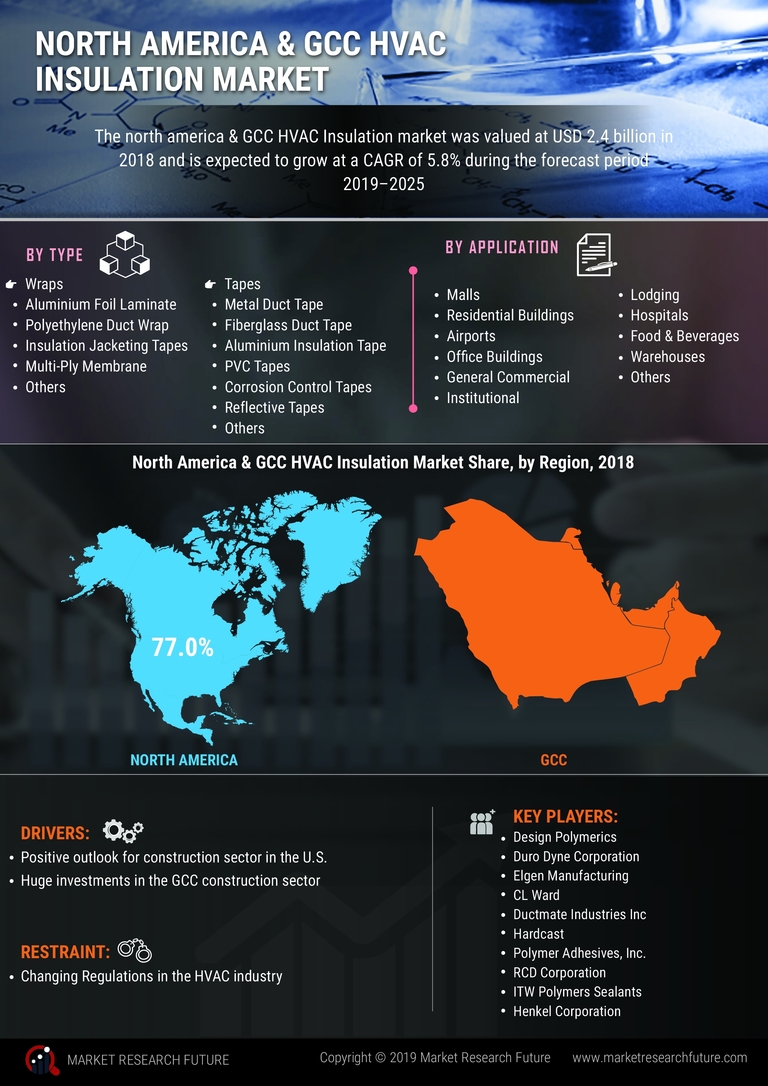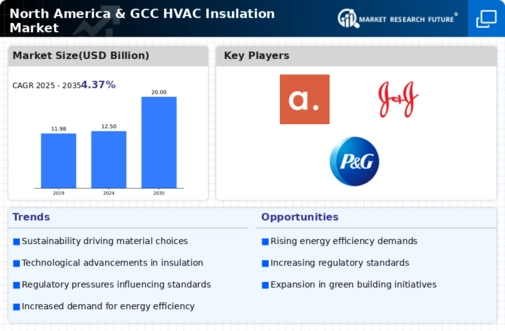Market Growth Projections
The Global North America and GCC HVAC Insulation Market Industry is projected to experience substantial growth over the next decade. With a market size expected to reach 12.5 USD Billion in 2024 and 20 USD Billion by 2035, the industry is poised for a robust expansion. The anticipated CAGR of 4.37% from 2025 to 2035 indicates a steady increase in demand for HVAC insulation products. This growth is driven by various factors, including rising energy efficiency standards, increased construction activities, and a growing emphasis on environmental sustainability. As the market evolves, it is likely to present new opportunities for manufacturers and stakeholders.
Growing Construction Activities
The Global North America and GCC HVAC Insulation Market Industry is significantly influenced by the ongoing expansion of construction activities. In North America, the construction sector is projected to grow steadily, driven by both residential and commercial projects. Similarly, the GCC region is witnessing a construction boom, particularly in countries like Saudi Arabia and the UAE, where mega projects are underway. This surge in construction is likely to increase the demand for HVAC insulation, as it is essential for maintaining indoor climate control and energy efficiency. The market is anticipated to reach 20 USD Billion by 2035, reflecting the robust growth in construction.
Government Incentives and Rebates
The Global North America and GCC HVAC Insulation Market Industry is positively impacted by various government incentives and rebate programs aimed at promoting energy-efficient upgrades. In North America, federal and state governments offer financial incentives for homeowners and businesses to invest in insulation improvements. Similarly, GCC countries are introducing initiatives to encourage energy conservation, which includes subsidies for insulation materials. These financial incentives lower the upfront costs associated with HVAC insulation installation, making it more accessible to a broader audience. As these programs gain traction, they are likely to stimulate demand within the market, contributing to its overall growth.
Rising Energy Efficiency Standards
The Global North America and GCC HVAC Insulation Market Industry is experiencing a surge in demand driven by increasing energy efficiency standards. Governments in both regions are implementing stringent regulations aimed at reducing energy consumption in buildings. For instance, the U.S. Department of Energy has set ambitious targets for energy efficiency, which necessitates the use of high-performance insulation materials. This trend is expected to contribute to the market's growth, with projections indicating a market size of 12.5 USD Billion in 2024. As energy efficiency becomes a priority, HVAC insulation plays a crucial role in achieving compliance with these standards.
Increased Awareness of Environmental Impact
The Global North America and GCC HVAC Insulation Market Industry is benefiting from a heightened awareness of environmental sustainability. Consumers and businesses alike are increasingly recognizing the importance of reducing carbon footprints and energy consumption. This shift in mindset is driving the adoption of eco-friendly insulation materials, which not only enhance energy efficiency but also contribute to environmental conservation. As a result, manufacturers are focusing on developing sustainable insulation solutions, which is likely to bolster market growth. The CAGR of 4.37% from 2025 to 2035 indicates a sustained interest in environmentally responsible products within the HVAC insulation sector.
Technological Advancements in Insulation Materials
The Global North America and GCC HVAC Insulation Market Industry is witnessing rapid advancements in insulation technologies. Innovations such as reflective insulation, spray foam, and advanced fiberglass materials are enhancing the performance and efficiency of HVAC systems. These technological improvements not only improve thermal performance but also reduce installation times and costs. As manufacturers continue to invest in research and development, the availability of high-performance insulation products is expected to increase. This trend is likely to attract more consumers, further driving the market's growth in the coming years, as energy efficiency becomes a critical factor in HVAC system design.














Leave a Comment